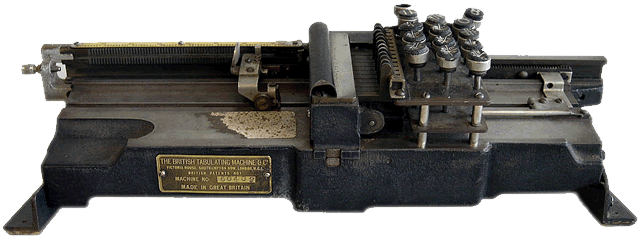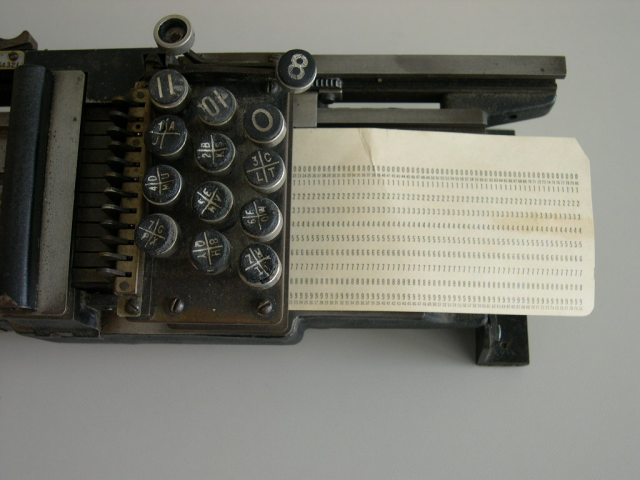 |
We are brick & mortar now!!
Visit us in Parkesburg, PA For more info: www.TheComputerChurch.org (This site no longer maintained.) |
YEAR: 1914
COMPANY: British Tabulating Machine Company, Limited
COUNTRY: England
IN OUR COLLECTION: Yes

The machine was hand operated and the process of pressing a key to punch a hole in the card would also advance the card one column. In 1923, IBM introduced an electically powered keypunch. Punching the holes in the card was not a quick process. The holepunch operated by sliding the card right to left underthe keypad and the holes were punched by the operator. However, the card had to be loaded from the left side of the keypad and slid under the keypad to the right where it fit snugly against a metal stop and under a round metal guide (see images). Then the left end of the card was clipped under the card guide and the operator would begin punching.
The keypad had total of 14 keys. The topmost key (on our machine the topmost key is missing the hard rubber inset), would allow the card to slide freely from right to left so that it could be removed from the hole punch. It would be the key you pressed when you were done punching holes. The second key from the top (on our machine it is marked with an "8") would advance the card one column without punching a hole, so it was used when the operator wanted to skip a column. The remaining 12 keys were used to punch holes.
Of these 12, the top three keys (on this machine they are keys "11", "10" and "0") punched above the normal area. We do not know what they were used for. (See below where Michael White has kindly explained how these keys were used in combination with other keys.)
The last nine keys were the heart of the hole punch and the wear and tear on the hard rubber tops of these keys indicated their considerble use. These keys were ordered from the top left key (#1) to the bottom right key (#12). You can follow the order in closeup images of the keypad...#1 to #2 to #3 moved from left to right on a slight downward angle, and then continued with #4, #5, #6 on the second row.
Each key was divided into four parts; the top left were the numbers, the top right were the letters "A" through "I", the bottom left were the letters "J" through "" and the bottom right were the letters "S" through "Z". Key #1 did not have a bottom right letter (otherwise we would have ended up with 27 letters!).
The manufacturer's tag indicates that this is machine #60402. We assume this is the serial number of this machine and not a model number. There is a marking under the machine with the number 918876. We do not know what the second number is for.
How old is this mechanical keypunch?
We are not sure when this keypunch was originally manufactured. We believe it to be between 1909 and 1919. We base that belief on the following clues from the nameplate on the keypunch. It wasn't until 1908 that Hollerith's Tabulating Machine Company gave an exclusive license to a company called Tabular Limited. The Tabular Limited changed its name to the British Tabulating Machine Company Limited in 1909. Since the nameplate lists the "British Tabulating Machine Co. Ltd." then it must have been made after 1909. BTM moved from Southhampton Row, London to Letchworth, Hertfordshire in 1920. Since the nameplate gives the address as Victoria House in London we can surmise that this keypunch was made before 1920. If you choose the midpoint of that time-span, it would place the keypunch at 1915.
If you have any information on this keypunch, please contact us.
I worked in British rail offices in Southampton in 1959 as a Hollerith Punchcard Operator . We were trained by a tutor from Park Lane in London . I really enjoyed the job but I can remember my index finger was always sore, Such memories.
I own a HOLLERITH punch card machine. the address on the machine is 17 Park Lane London W1. I used one of these in 1969 when I worked at British Rail.
Forgot to mention. for a UK spec punch the 10 and 11 keys were of course also used for pre-decimalisation currency of 10 and 11 pence. (12 pence to 1 shilling)
Just read your description of a card punch, noted the section on usage of keys. The keys "11", "10", and "0" were used in combination with other numeric keys to provide alphabetical characters and full stops, commas etc. No more than 3 keys could be used at the same time. Initially BTM punches used what was known as "2 zone alpha", it was then changed to "3 zone alpha". I worked with a number of Tabulator systems in the 1950s for a few years before progressing to computers.
|
Copyright © 2024 by Early Computers Project, All Rights Reserved. |
(Analogs in blue)
- AIM-65 (single board)
- AIM-65 (factory case)
- AIM-65 (Jon Titus)
- ALICE micro-ordinateur
- Altair 680
- Altair 8800
- Altair 8800A
- Altair 8800b
- Altair 8800b Turnkey (see Pertec below)
- Altair 8800b (see Pertec below)
- Altair 8800b w/ Hardisk Controller & Datakeeper
- Altos ACS-8000
- American Basic Science Club Analog Computer
- AMF Educational Computer
- Apple II Plus
- ASCI SystemX
- ASR 33 Teletype
- Automatic Teaching Computer Kit
- Beckman ElectroComp Electric Heating Computer
- Beckman ElectroComp Energy Savings Computer
- Beckman Solid State Fuel Cost Computer
- Brainiac K-30
- Calif. Computer Systems 2200
- CES Ed-Lab 650
- Commodore 8032
- Commodore 64
- Commodore PET 2001
- Commodore Super Pet
- Compucolor II
- Compukit 1
- Compukit 1 Deluxe Model
- Compukit 2
- Compukit UK101
- Comspace CT-650
- Cosmac Elf (RCA1802)
- Cosmac Microtutor
- Cosmac Netronics ELF II
- Cosmac VIP
- Cromemco System I
- Cromemco System III
- Cromemco Z-2D
- Datapoint 2200
- Digi-Comp I (flat box)
- Digi-Comp I (square box)
- Digital Computer Lab
- Donner 3500
- Durango F-85
- Dynabyte
- E & L Inst MMD-1
- E & L Inst MMD-2
- Eagle II
- Electric Tabulating Machine (one original counter, 1889)
- Electronic Associates TR-10
- Electronic Associates TR-10 Model II
- Electronic Associates TR-20
- Electronic Associates TR-48
- Electronic Associates Model 180
- Electronic Associates Model 380 Hybrid
- Geniac
- Google Glass (definitely not vintage)
- Heath EC-1 (factory assembled by Heath)
- Heathkit EC-1 (kit)
- Heathkit ET 3100 trainer
- Heathkit H8
- Heathkit H9 Video Terminal
- Hickok Logic Teaching Sys.
- Hickok Servo Teaching Sys.
- HP 2115A
- HP 85
- HP 5036A
- HP 9825A
- HP 9825B
- HP 9830A
- Iasis 7301
- I-COR MAC-1
- ICS Microcomputer Training System
- IMSAI 108 (prototype)
- IMSAI 8048 Control Computer
- IMSAI 8048 (The Dollhouse Computer)
- IMSAI 8080
- IMSAI PCS-40
- IMSAI PCS-80
- IMSAI VDP-80
- Informer
- Intel Intellec MDS
- Intel MDS-800
- Intel Prompt 48
- Intel SBC 80/10
- Intel SDK-85
- Intel SDK-85 (unassembled)
- Intel SDK-86
- Intertec Superbrain
- ITT MP-EX
- JR-01 Computer
- KIM-1
- LAN-DEC
- LAN-DEC 20
- LAN-ALOG
- Lehrcomputer (Germany)
- Lawrence Livermore Lab
- Lear Siegler ADM3A
- Logikit LK255 (Feedback)
- Logix SF-5000 Electronic Computer
- MAC-1 Mini Analog Computer
- MAC Tutor (Bell Laboratories)
- MEK6800D2
- Micro 68
- Microtan 65
- Midwest Scientific Instruments 6800
- Minivac 601
- Minivac 6010
- Mini-Scamp Microcomputer
- Nascom I
- Nascom II
- National Radio Institute 832
- NEC TK-80
- NorthStar Horizon
- Olivetti Programma 101
- Olivetti Programma 203
- Olivetti Programma 602
- Open University PT501
- Ordinateur d'Apprentissage JR-01
- Osborne 1
- OSI 300
- OSI 600 (SuperBoard II)
- OSI C2-OEM-4
- OSI Challenger-1P
- Pastoriza Personal Analogue Computer
- Pertec MITS 300/25 (Altair desk business system)
- Pertec MITS 300/55 (Altair Turnkey business system)
- PolyMorphic Systems 8810
- PolyMorphic Poly-88
- Protech-83
- Range Keeper Mk.6 Mechanical Analog Computer, 1926
- Range Keeper Mk.7 Mechanical Analog Computer, 1935?
- Sargent-Welch Scientific Company Cat. No.7528 Analog Computer
- Science of Cambridge MK-14 (Sinclair)
- SD Systems Z80 starter kit
- Sharp MZ-40K
- Sharp MZ-80k
- Siemens ECB-85
- Signetics Instructor 50
- Sinclair ZX-81
- Smoke Signal Broadcasting
- Sol-20
- Spark16
- Sphere 1
- Sphere/SWTPC Computer System
- SWTP CMOS Microlab
- SWTP CT-82 Terminal
- SWTPC 6800
- SWTPC 6800 (w/ Smoke Signal Broadcasting drive)
- SWTPC CT-64 Video Terminal, SS-50
- SWTPC TV Typewriter II CT-1024
- Synertek VIM-1
- Synertek SYM-1
- Systron-Donner 3500
- Tei MCS-112
- Tektronix 4006-1
- Telefunken RAT 700
- TI LCM-1001 (Microprogrammer)
- TI LCM-1001 (Microprogrammer)
- TI Silent 700 Terminal
- TI TM 990/189
- Vector 1
- Vector 3
- Vidac 336
- Wang 2200
- Welch Scientific Company Cat. No.7528 Analog Computer
- Xerox 820 Mark I
- Chameleon Plus
- Commodore SX64
- Epson HX-20
- Kaypro I
- Kaypro II
- Kaypro 2x
- Kaypro 16
- Osborne 1
- Panasonic Senior Partner
- Visual Commuter
- Babbage's Calculating Engine (1834)
- Electric Tabulating Machine (1889, Herman Hollerith's personal copy)
- The Hollerith Electric Tabulating System (1890)
- Counting a Nation by Electricity (1891)
- Calculating Machines (1947)
- Moore School Lectures Vol. II (1947)
- Mathematical Theory of Communication (1948)
- Communication Theory of Secrecy Systems (1949)
- The "Moore's Law" article (Electronics, 1965)
- Printout from Babbage's Difference Engine #2 (London Science Museum, 2004)




